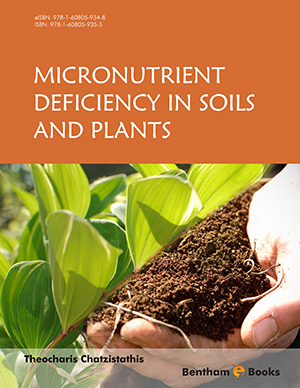Abstract
Zinc deficiency is one of the most important micronutrient deficiencies and many crops exhibit symptoms. There are many, soil and non-soil, factors influencing Zn solubility in soils and uptake by plants. Some of the most important factors are: pH, CaCO3, organic matter, cation exchange capacity (C.E.C.), soil humidity and temperature, soil texture, parent material, the quantity of Fe oxides and hydroxides in soils, the interaction with other nutrients, the genotypic ability to absorb Zn (such as the differential exudation capacity among genotypes), the formation of mycorrhiza, the different management and agronomical practices adopted by local farmers during crop production etc. Zinc may be taken up by plants either as Zn2+ or as Zn soluble organic chelates; Zn-deoxymugineic acid (DMA) complexes are the most referred ones in bibliography and the most prefered for uptake by some plant species (barley). Generally, Zn seems to be a mobile nutrient, easily transferred between vegetal tissues; under Zn deficient conditions many plant species are able to mobilize limited, but crucial for plant growth, quantities of Zn from older-mature- leaves to younger ones.
Zinc is very closely involved in N, carbohydrate and lipid metabolism of plants, as well as in protein and RNA synthesis. Of great importance is also the role of Zn on root membrane permeability. Generally, Zn levels below 20 p.p.m. are considered as deficient, so inorganic fertilization or organic amendment is needed. The non-typical Zn deficiency symptoms are usually those related to depressed plant growth, since Zn starvation negatively influences IAA concentration; from the typical symptoms, it should be distinguished the formation of clusters or rosettes of small stiff leaves at the ends of the young shoots in fruit trees etc. Some of the tolerance mechanisms adopted by plants in order to survive under Zn starvation include the enhanced exudation ability by tolerant genotypes, the antioxidant mechanisms in order to detoxify reactive oxygen species (ROS), the formation of mycorrhiza, the enhanced mobilization and translocation ability of Zn (usually from older to younger leaves) in tolerant genotypes etc. When leaf Zn concentrations are below the critical limits, Zn soil or foliar applications are needed. For that purpose, many substances, such as ZnSO4, or ZnEDTA may be used for the alleviation of Zn deficiency. However, some industrial by-products, varying from flue dust, reacted with sulphuric acid, to organic compounds, derived from the paper industry, may be also used for the correction of Zn starvation.
All the above mentioned topics concerning soil and non-soil factors influencing Zn solubility and uptake, the deficiency symptoms, the mechanisms of tolerance adopted by plants in order to face Zn starvation, as well as the methods of fertilizers’ application and the substances used to alleviate Zn deficiency are within the purposes of this chapter and they are fully developed and discussed.
Keywords: Zn availability, Zn deficiency, ZnEDTA, Zn fertilizers, ZnSO4, Zn tolerance, Zn uptake, Zn utilization efficiency.






















